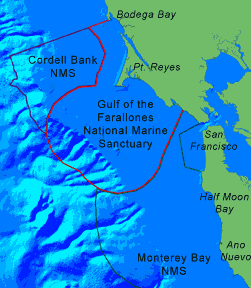
The north-central California coast is likely to experience rising seas, more extreme weather events and coastal erosion, increased ocean acidity, and shifting marine habitats as a result of climate change, according to a new report released today from the National Oceanic and Atmospheric Administration.
The report, “Climate Change Impacts: Gulf of the Farallones and Cordell Bank National Marine Sanctuaries,” was developed in collaboration with 16 agencies and organizations and was released today at the California Academy of Sciences in San Francisco.
“This report provides insight into how climate change will play out in our region, how the ocean environment in the Gulf of the Farallones and over Cordell Bank will change and how the organisms that live there will be impacted by it,” said the report’s lead author, oceanographer John Largier of the Bodega Marine Laboratory and UC Davis.
Largier was careful to explain that the report does not make predictions about the future, nor is it a complete assessment of current conditions.
“It’s a group of scientists getting together and making their best judgment of how things are changing, how things will change, and what are we most concerned about,” said Largier.
Topping the list of concerns, he said, are rising sea levels of approximately 1.5 meters by 2100, warming oceans, an increase in the variability of precipitation (drier dry years and wetter wet ones), and ocean acidification, which he called, “the other CO2 problem,” and stressed as both a global and regional concern.
“There are a lot of things we know that are happening. The real question we have to figure out now is how much this could all this change the ecosystem,” said Largier. “The system is so complex, it’s not totally clear how it’s going to evolve. Some populations might do a lot better with climate change, and others are going to be hammered. ”

The report makes some recommendations for the sanctuaries, including a greater focus on public education, implementing policies that allow for flexibility and adaptation to change, and mitigating other factors that impact the ecosystem such as pollution, invasive species, fishing, and infrastructure development.
“We are just now getting to the state where we say what does climate change mean for us, for my community?” said Largier. “It’s warming, sure, but what does it mean for ‘here’? How is it going to play out? And what are the things that are going to happen that really matter at a regional and local level? This is a huge scientific challenge that we are struggling with, but it’s an essential management and policy challenge.”
Bill Douros, the West Coast Regional Director of NOAA’s Marine Sanctuary program expressed the same sentiment in his opening remarks at the Cal Academy today.
“As we all know, the ocean is going to warm, it’s going to get more acidic, sea levels are going to rise, and those concepts are important, but what’s really important to someone who might be managing those marine protected areas is “How much?” and “By when are the sea levels going to rise and temp going to increase?” And that’s what this report today provides to us.”
Key Issues highlighted in the report:
⇒ Observed increase in sea level (100-year record at mouth of San Francisco Bay)
⇒ Expected increase in coastal erosion associated with changes in sea level and storm waves
⇒ Observed decrease in spring runoff of freshwater through San Francisco Bay (decreased Sierra snowpack)
⇒ Observed increase in precipitation variability (drier dry years, wetter wet years)
⇒ Observed increase in surface ocean temperature off the continental shelf
(50 year record)
⇒ Observed increase in winds driving coastal upwelling of nutrient-rich waters and
associated observed decrease in surface ocean temperature over the continental
shelf (30 year record)
⇒ Observed increase in extreme weather events (winds, waves, storms)
⇒ Expected decrease in seawater pH, due to uptake of CO2 by the ocean
⇒ Observed northward shift of key species (including Humboldt squid, volcano
barnacle, gray whales, bottlenose dolphins)
⇒ Possible shift in dominant phytoplankton (from diatom to dinoflagellate blooms)
⇒ Potential for effects of climate change to be compounded by parallel
environmental changes associated with local human activities
